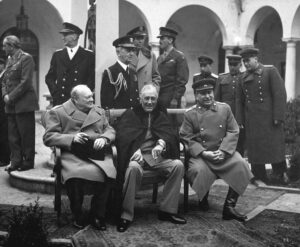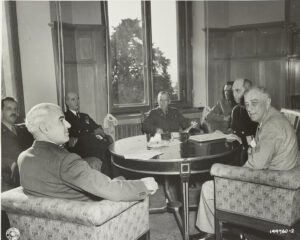
 What was known as the Yalta Conference, was held February 4 – 11, 1945. It was a meeting of the heads of government of the United States, the United Kingdom, and the Soviet Union, during World War II, to discuss the postwar reorganization of Germany and Europe, because it was becoming more and more evident that the war was winding down, and the Allies would be the victors. Representing the United States was President Franklin D Roosevelt. Prime Minister Winston Churchill represented the United Kingdom, and the Soviet Union was represented by General Secretary Joseph Stalin. Yalta is located in Crimea, Soviet Union, within the Livadia, Yusupov, and Vorontsov palaces.
What was known as the Yalta Conference, was held February 4 – 11, 1945. It was a meeting of the heads of government of the United States, the United Kingdom, and the Soviet Union, during World War II, to discuss the postwar reorganization of Germany and Europe, because it was becoming more and more evident that the war was winding down, and the Allies would be the victors. Representing the United States was President Franklin D Roosevelt. Prime Minister Winston Churchill represented the United Kingdom, and the Soviet Union was represented by General Secretary Joseph Stalin. Yalta is located in Crimea, Soviet Union, within the Livadia, Yusupov, and Vorontsov palaces.
As a war comes to a close, there must be some kind of a postwar strategy for shaping how the defeated nation will move into peacetime. They cannot be allowed to continue in the same direction that led to war in the first place, and the nations who won the victory will be key players in the newly formed alliance. They needed to shape a postwar peace that represented not only a collective security order, but also a plan to give self-determination to the liberated peoples of Europe, following years of oppression. The conference was intended mainly to discuss the re-establishment of the nations of war-torn Europe. Unfortunately, within a few years, and with the Cold War dividing the continent, the conference became a subject of intense controversy. There was a total of three conferences during World War II. They were known as the Big Three, and Yalta was the second one. The first was the Tehran Conference in November 1943 and the third was the Potsdam Conference in July of the same year as the Yalta Conference…1945. It was also preceded by a conference in Moscow in October 1944, not attended by Roosevelt, in which Churchill and Stalin had spoken about Western and Soviet spheres of influence in Europe.
Finally, on February 11, 1945, after a week of intensive bargaining by the three leaders of the Allied powers, the conference in Yalta ended. While the Yalta Conference was in session, the Western Allies liberated all of France and Belgium and were fighting on the western border of Germany. In the east, Soviet forces were 40 miles from Berlin, having already pushed back the Germans from Poland, Romania, and Bulgaria. These operations proved without a doubt that a German defeat was imminent. So, the focus moved toward shaping postwar Europe. With victory over Germany three months away, Churchill and Stalin were more intent on dividing Europe into zones of political influence than in addressing military considerations. Germany was to be divided into four occupation zones administered by the three major powers and France and was to be thoroughly demilitarized and its war criminals brought to trial. The Soviets were given the duty to administer those European countries they liberated but promised to hold free elections. The British and Americans would oversee the transition to democracy in countries such as Italy, Austria and Greece. Final plans were made for the establishment of the United Nations. A charter conference was scheduled for April in San Francisco.
President Roosevelt, just two months from his death, concentrated his efforts on gaining Soviet support for the United States war effort against Japan. The secret United States atomic bomb project had not yet tested a weapon, and it was estimated that an amphibious attack against Japan could cost hundreds of thousands of American lives. Stalin agreed, after being assured of an occupation zone in Korea, and possession of Sakhalin Island and other territories historically disputed between Russia and Japan, to enter the Pacific War within two to three months of Germany’s surrender. Most of the Yalta accords remained secret until after World War II, and the items that were revealed, such as “Allied plans for Germany and the United Nations, were generally applauded. Roosevelt returned to the United States exhausted, and when he went to address the U.S. Congress 
 on Yalta, he was no longer strong enough to stand with the support of braces. In that speech, he called the conference ‘a turning point, I hope, in our history, and therefore in the history of the world.'” Unfortunately, he was too sick to recover now. Roosevelt did not live long enough to see the iron curtain drop along the lines of division laid out at Yalta. In April, he traveled to his cottage in Warm Springs, Georgia, to rest and on April 12 died of a cerebral hemorrhage.
on Yalta, he was no longer strong enough to stand with the support of braces. In that speech, he called the conference ‘a turning point, I hope, in our history, and therefore in the history of the world.'” Unfortunately, he was too sick to recover now. Roosevelt did not live long enough to see the iron curtain drop along the lines of division laid out at Yalta. In April, he traveled to his cottage in Warm Springs, Georgia, to rest and on April 12 died of a cerebral hemorrhage.


Leave a Reply